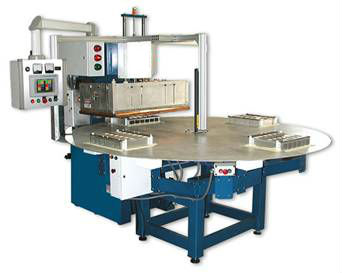RF Sealing Theory
Radio-frequency or... RF sealing, welding, heat sealing or… dielectric welding are all commonly used terms to describe a heating process by which radio-frequency electrical energy is passed through suitable nonconductive (dielectric) materials with a resulting substantial heating effect created within the dielectric target material.
Very simply .. this heating effect occurs because the modules of the dielectric material act much like bar magnets and will try to orientate or polarize themselves along with the high-frequency electro magnetic field . Because the field is reversing itself in excess of 27 million times per second (27 MHz), internal friction takes place between the molecules thus generating high heat.
Dielectric (nonconductive) materials exhibit the property of polarization because their molecular structure has strongly bound electrons; unlike that of conductive materials which have free or loosely bound electrons. Polarization can take place at both the atomic and molecular level.
There are at least four polarization mechanisms, which are significant at different frequencies:
Electronic Polarization — visible light frequency
Ionic Polarization — infrared frequency
Dipolar Polarization — radio and microwave frequency
Interfical Polarization — lower radio frequency
Under the influence of a rapidly alternating field, the realignment of the polarized components with that field gives rise to a friction effect resulting in the generation of heat within the material . heating effect may be due to more than one of the polarization mechanisms with any particular frequency or material.
Loss factor … is the heat ability of a material, the amount of energy it absorbs at radio and microwave frequencies.
Radio-frequency power... for industrial use is normally generated by a basic oscillator circuit using an industrial triode tube. The R.F. power is then transmitted through an applicator circuit (electrode) directly to the material to be heated.
Radio-frequency sealing... is accomplished by sending a high-frequency (heating) current through two or more layers of thermoplastic material placed between two sealing electrodes or dies.
One die is shaped in the image of the required seal. The other die may have the same shape or may be a flat plate. The dies are usually mounted in a pneumatic or hydraulic press to provide pressure for fusing the material. The seal is made as the generated high-frequency current heats and liquefies the material, whereupon the pressure exerted on the material brings about a thorough fusion. The current is then shut off, the material is allowed to solidify during a brief cooling period and the seal is completed.
The quality of the seal is determined by three factors:
- Heating current (R.F. power)
- Heating time
- Pressure
To some extent these three factors are independent of one another; i.e. a larger current or more pressure does not necessarily reduce the sealing time. The type and thickness of the material and the total area of the seal determine these factors.
Heating Time
As the power is turned on, the material heats up and its temperature rises. Naturally, as the temperature rises, heat is conducted off through the dies and the air until a state of heat balance is reached. At this point, the amount of heat generated within the plastic material remains constant. This temperature, indicating a sort of equilibrium condition between heat generated and heat loss in order to seal must be above the melting point of the plastic.
It is the time required (measured in seconds or fraction thereof) to reach this melting point that is defined as the heating time.
The heat loss is naturally greater with thinner material and less with thicker material. Indeed, very thin materials (less than .004") lose heat so rapidly that it becomes very difficult to seal them. From this it can be seen that, in general, thicker materials require less heating time than thinner materials. Furthermore, it was found that certain poor heat conductors that do not melt or deteriorate easily under the impact of high frequency could be used as buffers. Bakelite, Mylar, silicone glass and Teflon, for example, are excellent buffers and, therefore, help materially in improving the seal.
The usual heating periods range from one to four seconds. To minimize failures, it is suggested that the timer determining the heating cycle be set slightly above the minimum time found necessary for a good seal.
Pressure
The electrodes provide the heating current to melt the material and the pressure to fuse it.
Generally, the lower the pressure the poorer the seal. Conversely, a higher pressure will usually produce a better seal. However, too much pressure will result in an undue thinning out of the plastic material and in an objectionable extrusion along the sides of the seal. As a result of the two electrodes moving closer to each other, arcing may be caused, damaging the plastic, the buffer and possibly the die.
To obtain high pressure and yet avoid the above disadvantages, the moving die is restrained in its motion by a "stop" on the press that is set to prevent the dies from closing completely when there is no material between them. This prevents the die from cutting completely through the material and at the same time gives a seal of pre-determined thickness.
When a tear seal type of die is used, the stops are not set on the press, since a thinning of the tear seal area is desired. To insure a uniform seal, the proper pressure must be obtained at all points of the seal. To insure this, the dies are ground perfectly flat and held parallel to each other in the press. The dies must also be rigidly constructed to prevent warping under pressure.
Power
The amount of power required for a good seal is directly proportional to the area of the seal. Moreover, thicker materials require less power than thinner materials because thinner materials lose heat to the dies more rapidly. Our seal ability calculator shows the maximum area of seal obtainable with each unit. However, bear in mind that these figures are calculated for concentrated areas. The sealable area will be less for long thin seals and for certain materials that are hard to seal.
Buffers
In many cases sealing is improved by a thin layer of insulating material called a "buffer". This is attached to one or both dies to insulate the material to be sealed from the die. This does several things: it lowers the heat loss from the materials to the dies; it compensates for small irregularities in the die surface and may help to make a good seal even if the die is not perfectly flat; it decreases the tendency to arc when too much time or pressure is used. In general, it makes a better seal with less arcing. Buffer material should have good heat resistance and high voltage breakdown.
Applications
Thousands of radio-frequency sealers (welders) are currently in use throughout the United States. Many of which have been operating for 20 to 30 years. Thermatron R.F. welders are utilized for a wide variety of medical, industrial, automotive, aerospace, building material, clothing, cosmetic, & consumer packaging applications.





